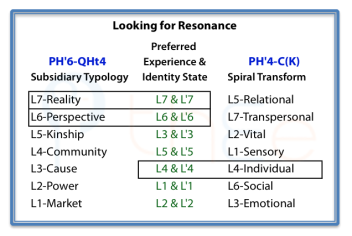
Analysing Resonance
![]() Of interest to THEE-dedicated investigators and developers only.
Of interest to THEE-dedicated investigators and developers only.
Understanding Resonance
Resonance is the phenomenon whereby psychosocial entities with similarities in their THEE-formulae show similarities in their psychosocial properties. These similarities may be substantial enough that careful discrimination is required to avoid confusing the entities. See examples.
Independently, certain features of and states were linked to the Approaches/Mentalities. The figure from that webpage is shown.
Here is the , showing the Primary Hierarchy and the Typology (nested within ) whose Levels formally draw on Primary Hierarchy Levels.
The self-boundary properties shown belong to the Typology, which exists to create a self that we can call our own. The Primary Hierarchy contains the various elements of experience that are used to construct the self-identity.
We have already specified the THEE hierarchical ordering of the via the THEE-Process and the ordering page.

Looking for Resonance
We can now investigate resonance by positioning our Subsidiary Typology [] dealing with alongside the []: as shown at right.
It seems that resonance only occurs at and . and often exhibit resonance across taxonomic frameworks; and this may be just another example. If so, it proves little.
A comparison can be made between the spiral-derived hierarchy resulting from transforming the Principal Typology.
However, this does not show even one correspondence to .

It is noted that the values in the Spiral correspond to the re-ordering of the forced by the ; the significance of this is not immediately apparent. It may be chance, or some feature of THEE that is as-yet undetermined.
Let’s Consider the Empirical Possibility
Beck & Cowan specified what looks like an «exemplification» of this THEEframework. It is related to the evolution of self-awareness and behavioural systems.
This ordering also corresponded to the conjectured order of exposure.
So the same comparison as above has been performed.

The THEE-Level numbers have remained attached to the Names (because they are part of the Names) and the new Beck & Cowan hypothesized levels are listed in purple.
The former and correspondence remains but, in addition, there is a correspondence at the new L5. There is also an additional correspondence with the spiral transform (). It is difficult to know what to make of this.
In the Final Analysis
We must now check how the description of self-boundaries aligns.

In the left column of the last table, the two diagonals have been separately listed in ascending order: Well-being from lower-left to upper-right; and from lower-right to upper-left.
The conjectured associated identity approach is placed in correspondence and then the nature of self-boundaries, defined by that system, is specified.
We see here that the clustering is 100% precise. That suggests to me that this is the phenomenon driving the relationship. It is overpowering the resonance, which given its weakness (cf. the formulae) is unsurprising, because the locations of the two frameworks within THEE are far apart.
Originally posted: July 2009